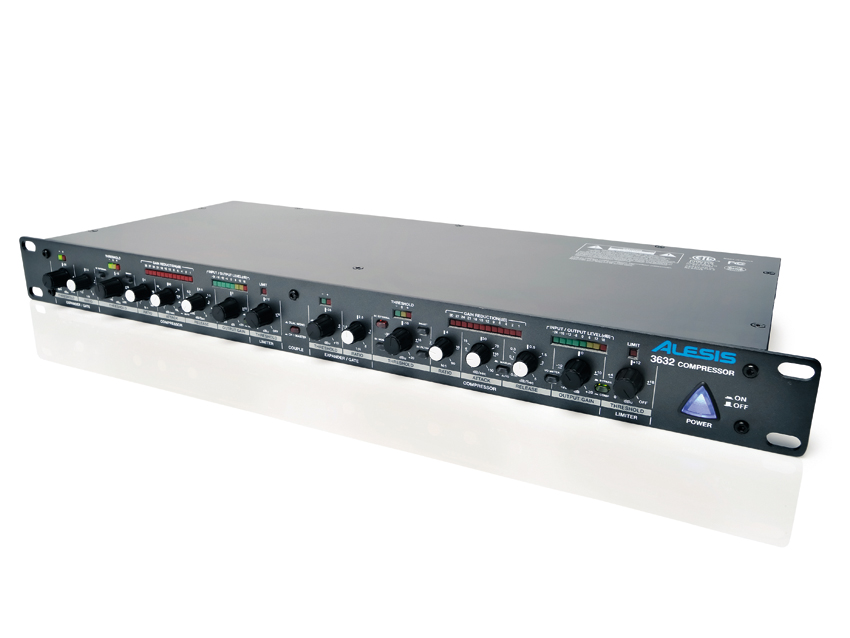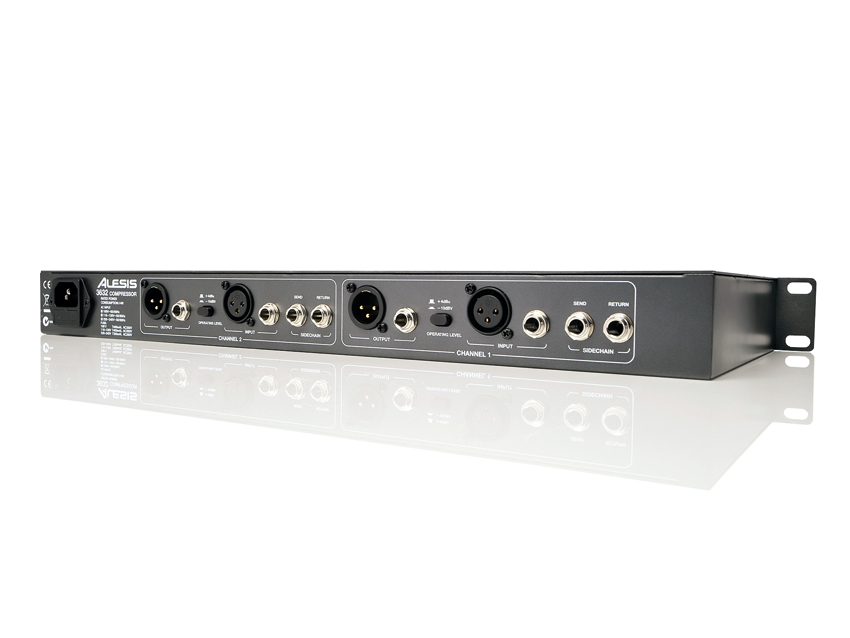MusicRadar Verdict
By no means high-end, but the 3632 offers significant improvements on the popular 3630 sound.
Pros
- +
Cheap, cheerful and versatile.
Cons
- -
Not the most refined.
MusicRadar's got your back

Alesis 3632 Compressor

Alesis 3632 Compressor
Two decades after it first hit the shelves, Alesis's 3630 compressor continues to divide opinion. Its detractors would have you believe that it's noisy and coloured, while devotees insist that its dirty, pumping character is precisely the appeal.
The 3630 is perhaps best known in electronic dance music circles for its association with the French House scene of the late '90s and 2000s. Daft Punk have stated that the sound of their Homework and Discovery albums was all down to the unique pumping charm of the 3630. Others claim that the boys were using an old Behringer Composer at the time.
"The 3632 doesn't necessarily excel on every type of material, but it's capable enough to do a suitable job on just about any signal with careful use."
Whether it's all some big Gallic in-joke, we'll probably never know, but we've certainly come across enough fans to believe that the 3630 is genuinely something of a cult classic in French house circles.
The fact that the 3630 has been one of the cheapest hardware compressors on the market for the entirety of its 20-year lifespan hasn't harmed its commercial success either. In fact, Alesis claims that the 3630 is the biggest selling compressor of all time.
The newly released 3632 on test here is, effectively, an updated version of the 3630. The basic features remain the same, but closer inspection reveals that there are more than enough changes to justify the new model name.
Can a budget hardware compressor really compete with plug-ins in 2012? Let's find out.
Spot the difference
Comparing the 3632 side-by-side with a 3630, the new model is about twice as deep and significantly heavier than the original. The extra bulk is explained by the fact that a beefed up internal power supply replaces the wall-wart used for the 3630.
The front-panel layout is noticeably different to the original, but the overall setup is similar: two channels of noise gate/expander and compression/limiting which can be linked in stereo mode or run independently as mono sections.
Round the back, the unbalanced external sidechain sends and returns are now on separate ¼" sockets, avoiding the need for custom cables. The original ¼" unbalanced inputs and outputs are replaced with balanced ¼" and XLR connections. Like the 3630, the 3632 can operate at -10dBV or +4dBu.
Poking around inside the 3632, the main differences from the 3630 are fairly small but significant. In addition to the new power supply, the circuit boards have been redesigned with cheaper, more efficient (but equally as good) surface mount components.
The design is essentially an updated version of the 3630, based around similar circuitry but with a handful of improvements to clean up the sound and bring it up to date. Most notably, the THAT 2150A VCAs found in the original are replaced with lower distortion, higher dynamic range 2181Bs.
Elsewhere, key components such as op amps have also been upgraded to more detailed, lower noise equivalents. Alesis has effectively carried out some of the most popular modifications applied to the 3630 in order to clean it up and improve its sound quality. The omens are good.
Operation
In operation, the 3632 is immediately reminiscent of its older brother. The noise gate section is cleaner than the much-maligned equivalent on the 3630.
Rather than its rate control, the 3632 offers a basic expander with an adjustable ratio, making it more versatile than the noisy all-or-nothing gate of the original. Forgive us for glossing over the gate/expander section here, but let's be honest: no one's buying the 3630 or 3632 for the gate.
The bottom line is that the 3630 made its name as a cheap and cheerful all-purpose compressor. It filled a gap at the lower end of the market before digital signal processing really took off as a mainstream option, then remained popular as a cheap and dirty alternative once technically superior compression plug-ins had flooded the market.
The very fact that the original design enjoyed a 20-year lifespan despite the arrival of DAWs and compressor plug-ins seems to prove that it had something to offer. In electronic music circles it may be best known as a tool for pumping mix buss compression or sidechain effects, but the original 3630 was designed as an all-rounder.
Testing the 3632 on a variety of signals, the same description certainly applies. It doesn't necessarily excel on every type of material, but it's capable enough to do a suitable job on just about any signal with careful use.
Although laid out and labelled slightly differently to the original, the 3632's controls are broadly similar. The ratio setting extends from 1:1 all the way up to ∞:1 for extreme brickwall limiting, while maximum attack time is slightly shorter than the original at 150ms (200ms on the 3630) but the release time control now extends up to five seconds (three on the 3630).
More restrained settings genuinely allow for transparent dynamic control, but at extreme settings the 3632 will happily destroy your signal with clipped transients and messy distortion. Some might see this as a flaw, but it's the price you pay for versatility and a good incentive to brush up on the fundamentals of compression.
Elsewhere, the 3632 retains the excellent metering of the 3630. The sidechain circuit is improved with the addition of a monitor button and a low-cut filter to tame response to bass-heavy material.
Rather than hard and soft knee settings, the 3632 offers a standard hard knee setting or a program-dependent 'smart' knee option for softer, more gentle effects. Likewise, an auto button replaces the similar RMS mode found on the 3630.
In auto mode, attack and release settings are automatically set based on the incoming signal, to good effect in some cases. At the end of the chain, a new limiter guards against spikes in output level.
While it's a nice idea in theory, it seriously harms the sound when it cuts in. Handy for overload protection perhaps, but probably not very usable for more musical purposes.
Conclusion
Only the most ardent 3630 fan would argue that it deserves to be ranked among the all-time great compressors. Nevertheless, the old timer remains popular for good reason. The 3632 improves on the 3630 in almost every way, from its cleaner, quieter performance all the way down to the convenience of the internal power supply.
A budget compressor like this will never score the highest marks when put up against more expensive competition. Likewise, it's unfair to expect hardware to compete with the versatility, ease of use and price of software alternatives.
However, no hardware compressor in this price range can really beat it for no-frills all-round dynamic control. It may be based on an old design but that's no reason to be put off.
The 3632 is a great option as a first hardware compressor, perfectly suited to getting hands-on experience of basic techniques, forcing yourself away from presets and learning what works and what doesn't.
Although we're mainly interested in it in a studio context, it's also reasonably well suited for live use. When compared to the 3630, the improved expander and new output limiter make the 3632 a better choice for live engineers on a budget.
Like the 3630 before it, the 3632 is clearly a budget compressor. If you're looking for perfectly transparent dynamic range control or effortless mix buss glue, it's probably not the best choice. But if you're after good basic compression, versatility and heaps of classic pumping sidechain character, the 3632 is a worth successor to the 3630's throne.
““We were arguing a lot and we were miserable”: How Green Day exceeded expectations with their most ambitious song
"There’s plenty for us guitarists to learn – and ‘less is more’ is the overriding lesson": how to play like George Harrison on The Beatles' Abbey Road
“They didn’t like Prince’s bikini underwear”: Prince’s support sets for the The Rolling Stones in 1981 are remembered as disastrous, but guitarist Dez Dickerson says that the the crowd reaction wasn’t as bad as people think









